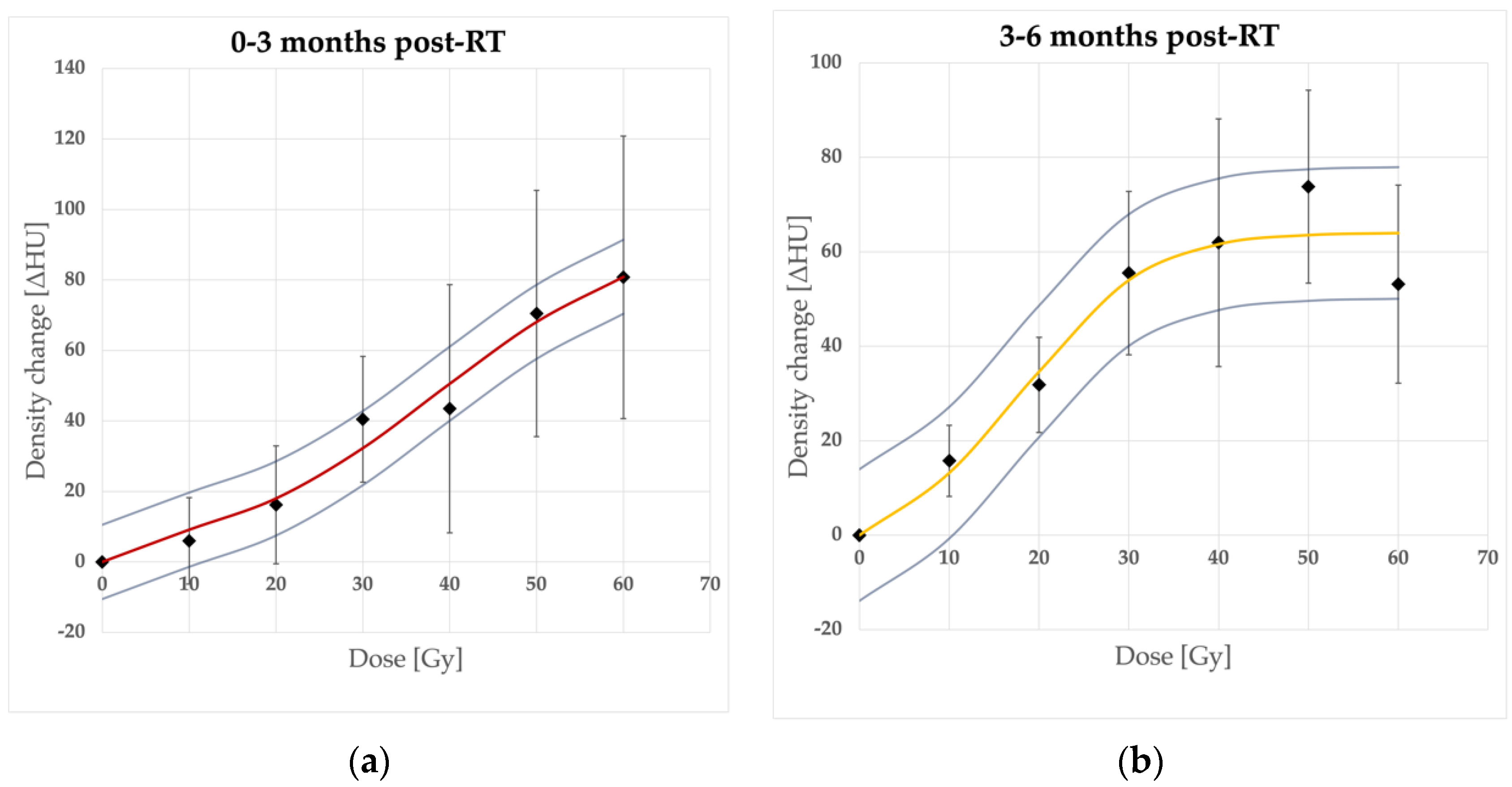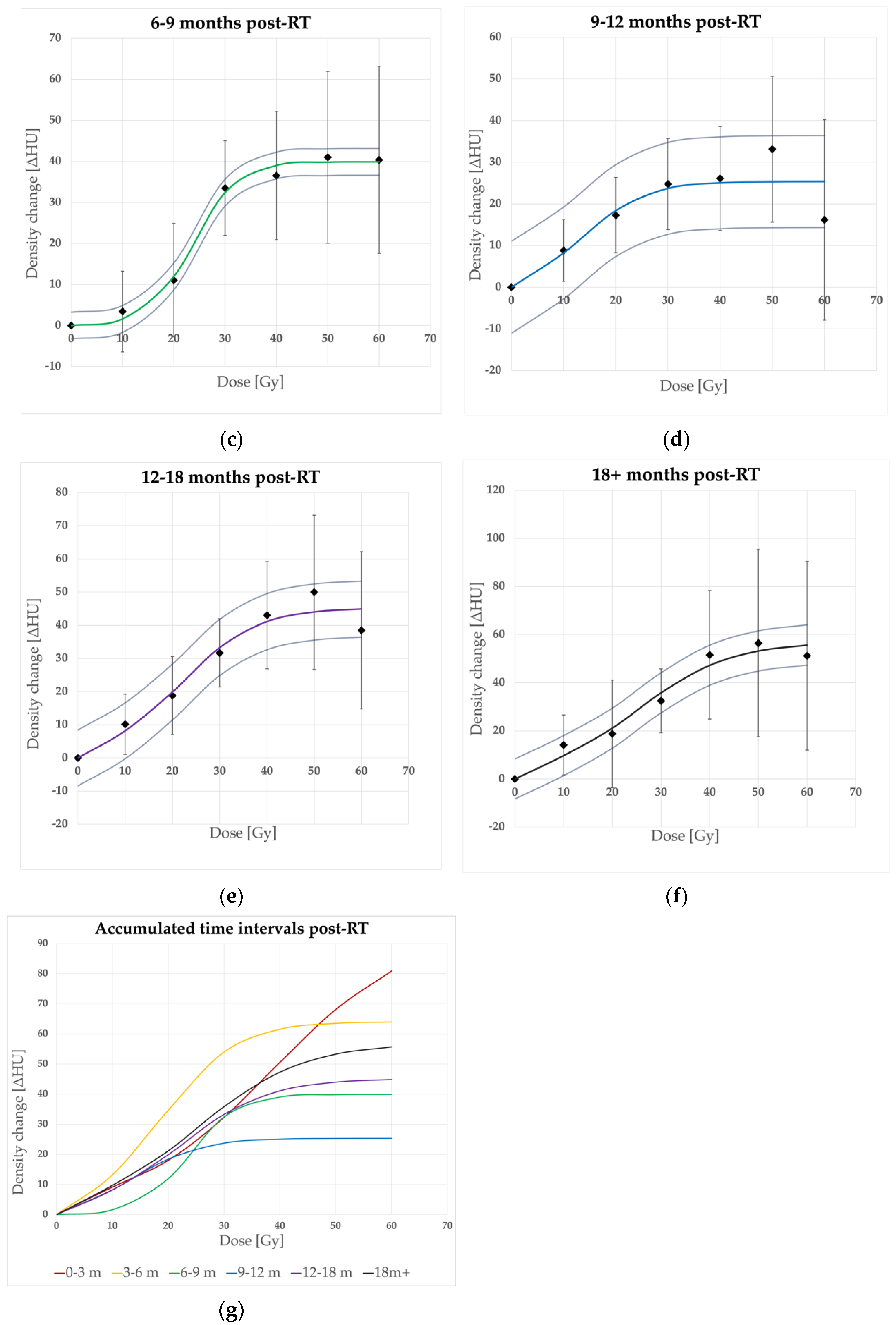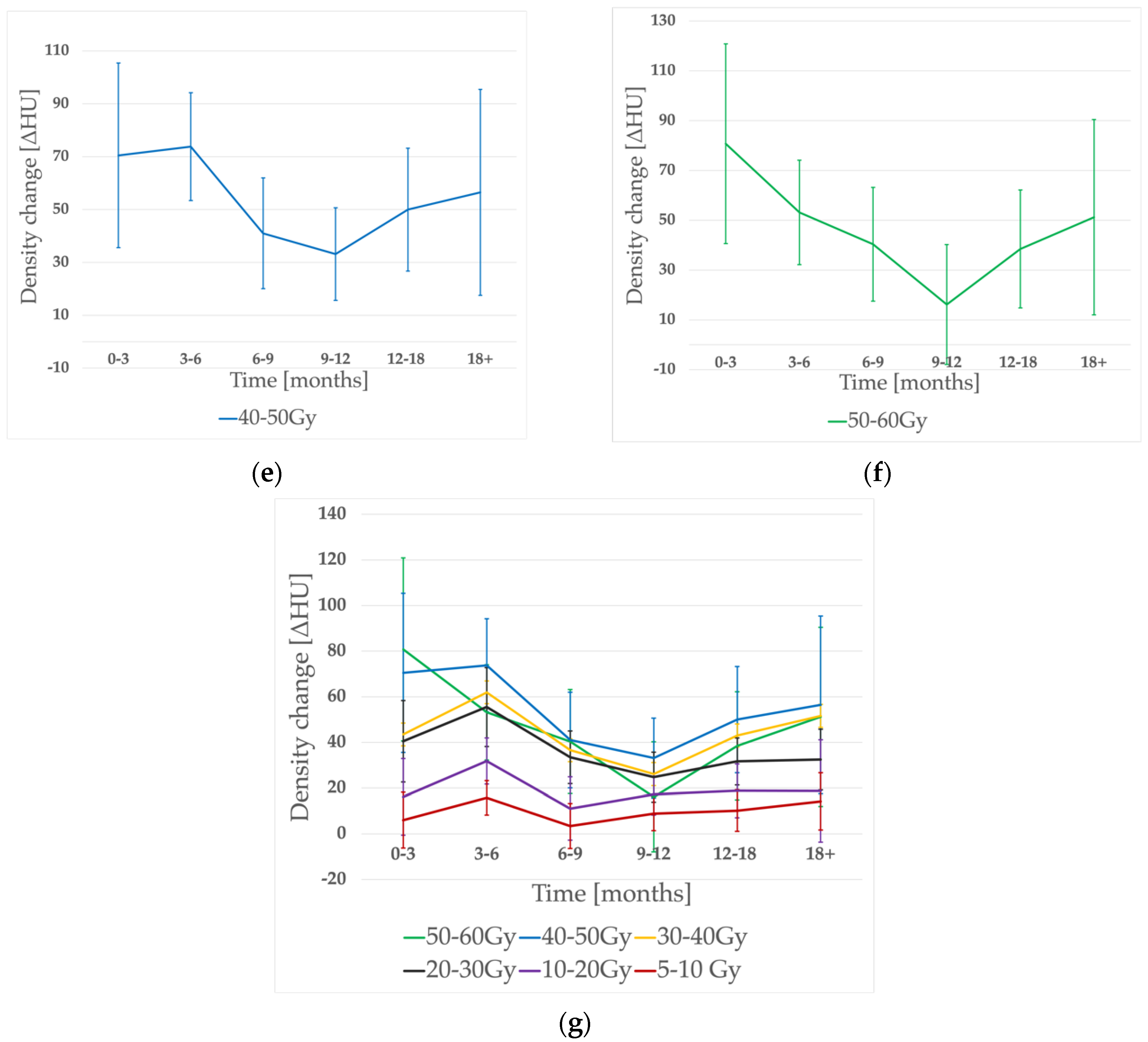Normal Lung Tissue CT Density Changes after Volumetric-Arc Radiotherapy (VMAT) for Lung Cancer
Abstract
:1. Introduction
2. Materials and Methods
2.1. Patient Characteristics
2.2. Software Workflow and Data Analysis
3. Results
3.1. Lung Density Changes in the Function of Dose
3.2. Time Evolution of Lung Density Changes
3.3. Factors Influencing Density Changes Degree
3.3.1. Clinical Factors Influencing the Early Phase (3–6 Months)
3.3.2. Clinical Factors Influencing the Late Phase (over 12 Months)
3.3.3. DCT Ventilation
4. Discussion
Author Contributions
Funding
Institutional Review Board Statement
Informed Consent Statement
Data Availability Statement
Conflicts of Interest
References
- Rahi, M.S.; Parekh, J.; Pednekar, P.; Parmar, G.; Abraham, S.; Nasir, S.; Subramaniyam, R.; Jeyashanmugaraja, G.P.; Gunasekaran, K. Radiation-Induced Lung Injury—Current Perspectives and Management. Clin. Pract. 2021, 11, 56. [Google Scholar] [CrossRef] [PubMed]
- Arroyo-Hernández, M.; Maldonado, F.; Lozano-Ruiz, F.; Muñoz-Montaño, W.; Nuñez-Baez, M.; Arrieta, O. Radiation-Induced Lung Injury: Current Evidence. BMC Pulm. Med. 2021, 21, 9. [Google Scholar] [CrossRef] [PubMed]
- Thomas, R.; Chen, Y.H.; Hatabu, H.; Mak, R.H.; Nishino, M. Radiographic Patterns of Symptomatic Radiation Pneumonitis in Lung Cancer Patients: Imaging Predictors for Clinical Severity and Outcome. Lung Cancer 2020, 145, 132–139. [Google Scholar] [CrossRef] [PubMed]
- Choi, Y.W.; Munden, R.F.; Erasmus, J.J.; Park, K.J.; Chung, W.K.; Jeon, S.C.; Park, C.K. Effects of Radiation Therapy on the Lung: Radiologic Appearances and Differential Diagnosis. Radiographics 2004, 24, 985–997. [Google Scholar] [CrossRef]
- Käsmann, L.; Dietrich, A.; Staab-Weijnitz, C.A.; Manapov, F.; Behr, J.; Rimner, A.; Jeremic, B.; Senan, S.; de Ruysscher, D.; Lauber, K.; et al. Radiation-Induced Lung Toxicity—Cellular and Molecular Mechanisms of Pathogenesis, Management, and Literature Review. Radiat. Oncol. 2020, 15, 214. [Google Scholar] [CrossRef] [PubMed]
- Saito, G.; Oya, Y.; Taniguchi, Y.; Kawachi, H.; Daichi, F.; Matsumoto, H.; Iwasawa, S.; Suzuki, H.; Niitsu, T.; Miyauchi, E.; et al. Real-World Survey of Pneumonitis and Its Impact on Durvalumab Consolidation Therapy in Patients with Non-Small Cell Lung Cancer Who Received Chemoradiotherapy after Durvalumab Approval (HOPE-005/CRIMSON). Lung Cancer 2021, 161, 86–93. [Google Scholar] [CrossRef]
- Hu, X.; Bao, Y.; Xu, Y.; Zhu, H.N.; Liu, J.S.; Zhang, L.; Guo, Y.; Jin, Y.; Wang, J.; Ma, H.L.; et al. Final Report of a Prospective Randomized Study on Thoracic Radiotherapy Target Volume for Limited-Stage Small Cell Lung Cancer with Radiation Dosimetric Analyses. Cancer 2020, 126, 840–849. [Google Scholar] [CrossRef] [PubMed]
- Shintani, T.; Kishi, N.; Matsuo, Y.; Ogura, M.; Mitsuyoshi, T.; Araki, N.; Fujii, K.; Okumura, S.; Nakamatsu, K.; Kishi, T.; et al. Incidence and Risk Factors of Symptomatic Radiation Pneumonitis in Non–Small-Cell Lung Cancer Patients Treated with Concurrent Chemoradiotherapy and Consolidation Durvalumab. Clin. Lung Cancer 2021, 22, 401–410. [Google Scholar] [CrossRef]
- Begosh-Mayne, D.; Kumar, S.S.; Toffel, S.; Okunieff, P.; O’Dell, W. The Dose—Response Characteristics of Four NTCP Models: Using a Novel CT-Based Radiomic Method to Quantify Radiation-Induced Lung Density Changes. Sci. Rep. 2020, 10, 10559. [Google Scholar] [CrossRef]
- Schröder, C.; Engenhart-Cabillic, R.; Kirschner, S.; Blank, E.; Buchali, A. Changes of Lung Parenchyma Density Following High Dose Radiation Therapy for Thoracic Carcinomas—An Automated Analysis of Follow up CT Scans. Radiat. Oncol. 2019, 14, 72. [Google Scholar] [CrossRef]
- Bernchou, U.; Schytte, T.; Bertelsen, A.; Bentzen, S.M.; Hansen, O.; Brink, C. Time Evolution of Regional CT Density Changes in Normal Lung after IMRT for NSCLC. Radiother. Oncol. 2013, 109, 89–94. [Google Scholar] [CrossRef]
- Defraene, G.; la Fontaine, M.; van Kranen, S.; Reymen, B.; Belderbos, J.; Sonke, J.J.; de Ruysscher, D. Radiation-Induced Lung Density Changes on CT Scan for NSCLC: No Impact of Dose-Escalation Level or Volume. Int. J. Radiat. Oncol. Biol. Phys. 2018, 102, 642–650. [Google Scholar] [CrossRef] [PubMed]
- Avanzo, M.; Barbiero, S.; Trovo, M.; Bissonnette, J.P.; Jena, R.; Stancanello, J.; Pirrone, G.; Matrone, F.; Minatel, E.; Cappelletto, C.; et al. Voxel-by-Voxel Correlation between Radiologically Radiation Induced Lung Injury and Dose after Image-Guided, Intensity Modulated Radiotherapy for Lung Tumors. Phys. Med. 2017, 42, 150–156. [Google Scholar] [CrossRef] [PubMed]
- Palma, D.A.; van Sörnsen De Koste, J.; Verbakel, W.F.A.R.; Vincent, A.; Senan, S. Lung Density Changes after Stereotactic Radiotherapy: A Quantitative Analysis in 50 Patients. Int. J. Radiat. Oncol. Biol. Phys. 2011, 81, 974–978. [Google Scholar] [CrossRef] [PubMed]
- Al Feghali, K.A.; Wu, Q.; Devpura, S.; Liu, C.; Ghanem, A.I.; Wen, N.; Ajlouni, M.; Simoff, M.J.; Movsas, B.; Chetty, I.J. Correlation of Normal Lung Density Changes with Dose after Stereotactic Body Radiotherapy (SBRT) for Early Stage Lung Cancer. Clin. Transl. Radiat. Oncol. 2020, 22, 1–8. [Google Scholar] [CrossRef] [PubMed] [Green Version]
- Konkol, M.; Śniatała, K.; Śniatała, P.; Wilk, S.; Baczyńska, B.; Milecki, P. Computer Tools to Analyze Lung CT Changes after Radiotherapy. Appl. Sci. 2021, 11, 1582. [Google Scholar] [CrossRef]
- Jones, B.; Dale, R.G.; Deehan, C.; Hopkins, K.I.; Morgan, D.A.L. The Role of Biologically Effective Dose (BED) in Clinical Oncology. Clin. Oncol. 2001, 13, 71–81. [Google Scholar] [CrossRef]
- Diot, Q.; Marks, L.B.; Bentzen, S.M.; Senan, S.; Kavanagh, B.D.; Lawrence, M.V.; Miften, M.; Palma, D.A. Comparison of Radiation-Induced Normal Lung Tissue Density Changes for Patients from Multiple Institutions Receiving Conventional or Hypofractionated Treatments. Int. J. Radiat. Oncol. Biol. Phys. 2014, 89, 626–632. [Google Scholar] [CrossRef] [PubMed]
- Hanania, A.N.; Mainwaring, W.; Ghebre, Y.T.; Hanania, N.A.; Ludwig, M. Radiation-Induced Lung Injury: Assessment and Management. Chest 2019, 156, 150–162. [Google Scholar] [CrossRef]
- Torre-Bouscoulet, L.; Muñoz-Montaño, W.R.; Martínez-Briseño, D.; Lozano-Ruiz, F.J.; Fernández-Plata, R.; Beck-Magaña, J.A.; García-Sancho, C.; Guzmán-Barragán, A.; Vergara, E.; Blake-Cerda, M.; et al. Abnormal Pulmonary Function Tests Predict the Development of Radiation-Induced Pneumonitis in Advanced Non-Small Cell Lung Cancer. Respir. Res. 2018, 19, 72. [Google Scholar] [CrossRef] [PubMed] [Green Version]
- Dang, J.; Li, G.; Zang, S.; Zhang, S.; Yao, L. Comparison of Risk and Predictors for Early Radiation Pneumonitis in Patients with Locally Advanced Non-Small Cell Lung Cancer Treated with Radiotherapy with or without Surgery. Lung Cancer 2014, 86, 329–333. [Google Scholar] [CrossRef] [PubMed]
- Huang, E.X.; Hope, A.J.; Lindsay, P.E.; Trovo, M.; El Naqa, I.; Deasy, J.O.; Bradley, J.D. Heart Irradiation as a Risk Factor for Radiation Pneumonitis. Acta Oncol. 2011, 50, 51–60. [Google Scholar] [CrossRef] [PubMed] [Green Version]
- Yorke, E.D.; Jackson, A.; Kuo, L.C.; Ojo, A.; Panchoo, K.; Adusumilli, P.; Zauderer, M.G.; Rusch, V.W.; Shepherd, A.; Rimner, A. Heart Dosimetry Is Correlated with Risk of Radiation Pneumonitis after Lung-Sparing Hemithoracic Pleural Intensity Modulated Radiation Therapy for Malignant Pleural Mesothelioma. Int. J. Radiat. Oncol. Biol. Phys. 2017, 99, 61–69. [Google Scholar] [CrossRef] [PubMed]
- Palma, D.A.; Senan, S.; Tsujino, K.; Barriger, R.B.; Rengan, R.; Moreno, M.; Bradley, J.D.; Kim, T.H.; Ramella, S.; Marks, L.B.; et al. Predicting Radiation Pneumonitis after Chemoradiation Therapy for Lung Cancer: An International Individual Patient Data Meta-Analysis. Int. J. Radiat. Oncol. Biol. Phys. 2013, 85, 444–450. [Google Scholar] [CrossRef] [PubMed] [Green Version]
- Vogelius, I.R.; Bentzen, S.M. A Literature-Based Meta-Analysis of Clinical Risk Factors for Development of Radiation Induced Pneumonitis. Acta Oncol. 2012, 51, 975–983. [Google Scholar] [CrossRef] [Green Version]
- Bledsoe, T.J.; Nath, S.K.; Decker, R.H. Radiation Pneumonitis. Clin. Chest Med. 2017, 38, 201–208. [Google Scholar] [CrossRef]
- Palma, D.A.; van Sörnsen de Koste, J.R.; Verbakel, W.F.A.R.; Senan, S. A New Approach to Quantifying Lung Damage after Stereotactic Body Radiation Therapy. Acta Oncol. 2011, 50, 509–517. [Google Scholar] [CrossRef] [PubMed]
- Brennan, D.; Schubert, L.; Diot, Q.; Castillo, R.; Castillo, E.; Guerrero, T.; Martel, M.K.; Linderman, D.; Gaspar, L.E.; Miften, M.; et al. Clinical Validation of 4-Dimensional Computed Tomography Ventilation with Pulmonary Function Test Data. Int. J. Radiat. Oncol. Biol. Phys. 2015, 92, 423–429. [Google Scholar] [CrossRef] [PubMed] [Green Version]
- Vinogradskiy, Y.; Rusthoven, C.G.; Schubert, L.; Jones, B.; Faught, A.; Castillo, R.; Castillo, E.; Gaspar, L.E.; Kwak, J.; Waxweiler, T.; et al. Interim Analysis of a Two-Institution, Prospective Clinical Trial of 4DCT-Ventilation-Based Functional Avoidance Radiation Therapy. Int. J. Radiat. Oncol. Biol. Phys. 2018, 102, 1357–1365. [Google Scholar] [CrossRef] [PubMed]
- Faught, A.M.; Miyasaka, Y.; Kadoya, N.; Castillo, R.; Castillo, E.; Vinogradskiy, Y.; Yamamoto, T. Evaluating the Toxicity Reduction with Computed Tomographic Ventilation Functional Avoidance Radiation Therapy. Int. J. Radiat. Oncol. Biol. Phys. 2017, 99, 325–333. [Google Scholar] [CrossRef]
- Castillo, E.; Nair, G.; Turner-Lawrence, D.; Myziuk, N.; Emerson, S.; Al-Katib, S.; Westergaard, S.; Castillo, R.; Vinogradskiy, Y.; Quinn, T.; et al. Quantifying Pulmonary Perfusion from Noncontrast Computed Tomography. Med. Phys. 2021, 48, 1804–1814. [Google Scholar] [CrossRef] [PubMed]




| Patients’ Characteristics | Treatment Characteristics | ||
|---|---|---|---|
| Total number of pts. | 47 | Mean total dose (Gy) | 57 (30–66) |
| Median age | 66 (52–82) | Fraction dose (2 Gy/3 Gy) | 34/13 |
| Women/men | 20/27 | Mean PTV volume (cm3) | 217 (47–645) |
| NSCLC/SCLC | 43/4 | Mean V5_lung (%) | 46 (12–71.7) |
| Preceding surgery (yes/no) | 13/34 | Mean V20_lung (%) | 17.2 (4.6–31) |
| Sequential chemo (yes/no) | 37/10 | Mean lung doses (Gy) | 10.36 (3.4–16.5) |
| Chemo type | PN (27), KN (4), PE (3), KE (2), NVB mono (1) | Mean V5_heart (%) | 37.43 (0–93.5) |
| Total number of follow-up CTs | 120 | Mean V40_heart | 3.53 (0–14.8) |
| Time distribution of follow-up CTs 1 | 0–3 m (12), 3–6 m (30), 6–9 m (18), 9–12 m (26), 12–18 m (22), 18 m+ (11) | Mean heart doses (Gy) | 7.86 (0.124–23) |
| Comorbidities 2 | COPD (10), AH (24), DM (8) | ||
| Rad. pneumonitis 3 | G1 (0), G2 (2), G3+ (0) | ||
| Time from RT | ΔHUmax (HU) | D50 | D95 | γ | R2 |
|---|---|---|---|---|---|
| 0–3 months | 96 (85.5–106.5) | 38.6 Gy | 70.2 Gy | 0.76 | 0.98 |
| 3–6 months | 64.1 (50.1–78) | 18.9 Gy | 38.4 Gy | 0.71 | 0.94 |
| 6–9 months | 39.9 (36.6–43.1) | 23.7 Gy | 36.4 Gy | 1.36 | 0.99 |
| 9–12 months | 25.4 (14.4–36.4) | 14.3 Gy | 31.6 Gy | 0.61 | 0.80 |
| 12–18 months | 45.2 (36.7–53.7) | 21.9 Gy | 45.1 Gy | 0.69 | 0.96 |
| Over 18 months | 57.1 (48.8–65.4) | 25.1 Gy | 53 Gy | 0.66 | 0.97 |
Publisher’s Note: MDPI stays neutral with regard to jurisdictional claims in published maps and institutional affiliations. |
© 2022 by the authors. Licensee MDPI, Basel, Switzerland. This article is an open access article distributed under the terms and conditions of the Creative Commons Attribution (CC BY) license (https://creativecommons.org/licenses/by/4.0/).
Share and Cite
Konkol, M.; Bryl, M.; Fechner, M.; Matuszewski, K.; Śniatała, P.; Milecki, P. Normal Lung Tissue CT Density Changes after Volumetric-Arc Radiotherapy (VMAT) for Lung Cancer. J. Pers. Med. 2022, 12, 485. https://doi.org/10.3390/jpm12030485
Konkol M, Bryl M, Fechner M, Matuszewski K, Śniatała P, Milecki P. Normal Lung Tissue CT Density Changes after Volumetric-Arc Radiotherapy (VMAT) for Lung Cancer. Journal of Personalized Medicine. 2022; 12(3):485. https://doi.org/10.3390/jpm12030485
Chicago/Turabian StyleKonkol, Marek, Maciej Bryl, Marek Fechner, Krzysztof Matuszewski, Paweł Śniatała, and Piotr Milecki. 2022. "Normal Lung Tissue CT Density Changes after Volumetric-Arc Radiotherapy (VMAT) for Lung Cancer" Journal of Personalized Medicine 12, no. 3: 485. https://doi.org/10.3390/jpm12030485
APA StyleKonkol, M., Bryl, M., Fechner, M., Matuszewski, K., Śniatała, P., & Milecki, P. (2022). Normal Lung Tissue CT Density Changes after Volumetric-Arc Radiotherapy (VMAT) for Lung Cancer. Journal of Personalized Medicine, 12(3), 485. https://doi.org/10.3390/jpm12030485







